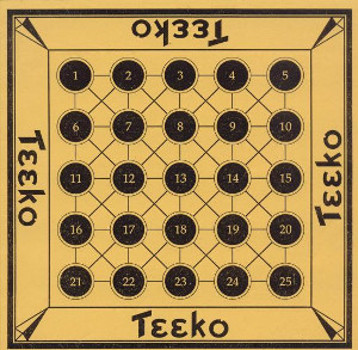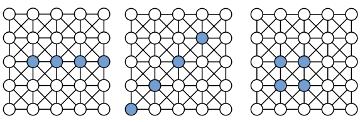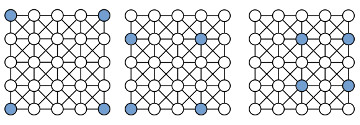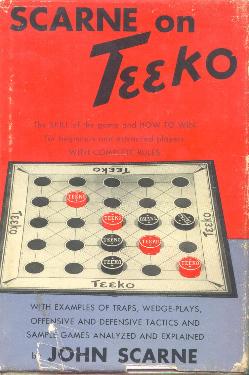Teeko
Written by Howard Fosdick © BestFreeNewGames.com
Overview:
If you like checkers, chess, and other abstract board games, here's a fun new one to try. It's deceptively simple -- I can tell you the rules in a single paragraph. But watch out! You'll find yourself in deep thought if you take winning seriously.
I like Teeko because -- like table tennis or "Ping-Pong" -- people of any level of skill can have a great time playing the game. You don't have to be an expert to enjoy it. This webpage is one of only a handful of pages on the web devoted exclusively to Teeko.
Teeko was invented by John Scarne, world-class gambling expert and magician. He invented dozens of games, including card games we provide rules to, such as Skarney Gin and Skarney. Scarne also created original dice games, and board games like Scarney and Teeko. You can read about Scarne's rather unusual life here.
Mr. Scarne worked on Teeko intermittently from the late 1930’s to the early 1960’s. Though he published best-selling game books, and entertained everyone from mobsters to Presidents with his card tricks, he felt Teeko would be his lasting legacy to the world. As he states in the introduction to his Teeko book, "I firmly believe that the creation of Teeko plus the writing of this book will stand out as the achievements of my life." This was not to be, and the game faded from public view. Nevertheless, Teeko remains an intriguing strategy game for two players that offers innumerable variations and provides lots of enjoyment even today.
Make Your Own Teeko Game:
Teeko is no longer produced. You might find an old game for sale, but you can instead just click on the picture below to see a playable, printable board. Or visit this page. For the markers, you can use the pieces from any game that uses two colours of markers, like checkers, Go, Gomoku, Renju, or other game.
The Board: Here's how the playing area looks:

How to Play Teeko:
The basic rules of “Standard Teeko” are simple. Each player has four pieces or markers of his own color.
In Phase I, players alternately place one of their pieces on any board position.
In Phase II, they move any one of their own pieces to an adjacent position. The object of the game is for either player to win by having his markers situated in a straight line (vertical, horizontal, or diagonal) or a square of four adjacent spaces.
See the figure for example winning positions.
Variations: Scarne developed dozens of different rule sets for Teeko. He felt that part of the value of the game was that one could play so many different variations with the same simple equipment.
The ultimate authority for game rules is Scarne's book, Scarne on Teeko, published in the late 1950s. If you're really interested in the game, you can usually find a used copy online. This definitive 265-page book lists numerous variations on standard Teeko, including Alternate Teeko and Advanced Teeko. A photo of the book cover appears at the bottom of this page.
Mr Scarne frequently revised Teeko rules and invented innumerable variations. You might find different rules for the game depending on the source you use -- the rules even varied among different releases of the game from Scarne’s company. Remember that, among Teeko players, the Teeko book is considered the ultimate authority.

Here we offer for free download three different Teeko booklets Scarne wrote over the years. It's fun to try his different game variations and see which you prefer:
- Teeko Rules Booklet #1
- Teeko Rules Booklet #2 -- includes rules for the Alternate Teeko Game
- Teeko Advanced Rules Booklet -- includes rules for the Advanced Game
Alternate Teeko: Scarne presents too many Teeko variations to cover them all here. But in brief, in Phase I of standard Teeko, the players alternate placing their markers onto the board, one per turn. In Alternate Teeko, players take turns placing their opponents' markers onto the board. A player may say "pass" during any turn, in which case the other player can place the marker where he chooses.
Advanced Teeko: To win in standard Teeko, players must arrange their four markers either into a row, or a square block of adjacent markers. In Advanced Teeko, another winning position is introduced, that of the "extended" square. In this case the four markers still describe a square -- but the markers need not be immediately adjacent. See the figure for examples.

What Ever Happened to Teeko? Mr Scarne was a self-made man who rose to fame and fortune through dint of hard work, serious study, and industrious self-promotion. But his efforts didn’t pan out with Teeko. Though he stated that he sold over one hundred thousand Teeko sets in the period 1952 to 1955, the game had faded from view by the mid-1960’s. Teeko was manufacturered by John Scarne Games Inc. of Fairview, New Jersey, and you might still find a used game online today. Or click here to make your own Teeko board and game set.
The Famous “Teeko Challenge”: As part of his promotional effort for Teeko, Mr. Scarne held Teeko tournaments in New York and New Jersey during the 1950’s. The most famous match was at New York’s well-known 21 Club in March 1955, when he played ten simultaneous games and offered $1,000 to any opponent who beat him. Players included celebrities of the day such as Steve Allen, Frances Langford, Judy Holliday, Jinx Falkenberg, and Walter Slezak. Some of the tougher opponents were chess champion Larry Evans, checkers champion Tommy Wiswell, and bridge and backgammon expert John Crawford. Fortunately for Scarne, he didn’t lose a game!
The photograph shows the Teeko Challenge underway. Scarne is standing, roving between celebrities with whom he is each playing game. Pictured are, left to right, Steve Allen, Larry Evans, Frances Langford, John Crawford, Jinx Falkenberg, Walter Slezak, and Judy Holliday.

Teeko Was “Solved” by Computer:
Computer scientist Guy Steele “solved” Teeko by computer in 1998. That is, his computer program proved that in the standard game neither player can force a win if both players play optimally and without error. Of the 16 Advanced Teeko games, 14 would be won by Black and two would be draws, again assuming both players play optimally.
Teeko -- The Mini-Opera: Composer Mark Owen created a short opera based on Teeko which he named Teeko. The work included such songs as “Why Do You Recommend Teeko for the Sick?” and “Teeko Is Rapidly Sweeping the World”. The only recorded performance of the score was at Trinity College, Cambridge, in January 1991. It lasted about thirty minutes.
Download a copy of the score here.Scarney: Mr. Scarne developed and marketed several other board games through his Fairview, New Jersey games company. Scarney was a similar strategy game to Teeko, and like Teeko, Mr. Scarne sold different versions of the game over the years. A publicity photo from 1961 over at Scarne's biography page shows Scarne playing his newly-introduced version of Scarney. You'll notice that the Scarney board and playing pieces are highly similar to Teeko.
Teeko on your Computer:
Zillions of Games offers Teeko and many other games for Windows. You must purchase their "games engine" to run it.
BoardGameGeek has a feature where you can play Teeko and other board games online in real time.

-----------------------------------
Print Your Own Game Board:
Want to print your own game boards? Click here to download printable game boards for any game on this website. You don't need to buy anything to play!
More on Scarne and Teeko: Read our own biography of the fascinating Mr. Orlando Carmelo Scarnnechia (aka John Scarne) here.
If you like board games, see our pages on Ringo, Camelot/Cam/Camette, Brandubh and Fitchneal, and The Jungle Game. Or just go to our board games home page here.
You can play a browser-based version of Teeko online
here.

Click here for more free games on this website.
-----------------------------------
License: Feel free to print, copy, and distribute these rules, so long as you retain this paragraph. Written by Howard Fosdick © 2023, distributed under Creative Commons License BY-ND. Photo credits on this page: from John Scarne's autobiographies.